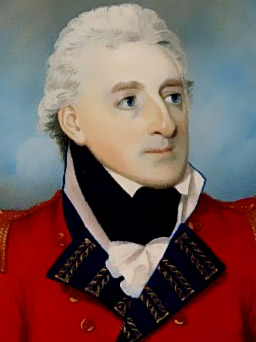 The Marathas rallied at Laswari, thirty miles north-west of Agra, where Gerard Lake came upon them at sunrise, November. They were strongly posted and had cut a reservoir`s banks, to flood the approaches. Without waiting for his infantry, whom he had left toiling far behind, Lake flung his cavalry at the enemy`s artillery position. The gunners held their fire until the cavalry were within twenty yards; and they fought with such desperation that after the battle Lake enlisted their survivors in the Company`s service.
The Marathas rallied at Laswari, thirty miles north-west of Agra, where Gerard Lake came upon them at sunrise, November. They were strongly posted and had cut a reservoir`s banks, to flood the approaches. Without waiting for his infantry, whom he had left toiling far behind, Lake flung his cavalry at the enemy`s artillery position. The gunners held their fire until the cavalry were within twenty yards; and they fought with such desperation that after the battle Lake enlisted their survivors in the Company`s service.
Gerard Lake did what was the equivalent in the First World War of attacking without artillery preparation, and the cavalry failed to oust the enemy. The infantry arrived about eleven o`clock, breathless and dusty. The Marathas faltered, and opened negotiations, being given an hour, which both sides used to strengthen themselves. During the noon, Lake guided the infantry into their last mile, of which they managed to traverse most unseen, by using nullas and luxuriant grasses. On emergence they were met with a terrific fire, which ravaged the devoted 76th Regiment in particular. Lake`s charger was killed, and his son, Major Lake, dismounting to offer his own, was struck down. Lake could not pause for even his wounded son but had to gallop off to bring up the 12th and 16th Native Infantry to assist the 76th. An attack made by Maratha cavalry on the flank was feeble and the battle began to fade out from Laswari. It gathered vigour in the village of Malpur, where resistance continued until four in the afternoon and till then the Maratha ruin was complete. The loss came to the British heavily and over 800 people lied dead and wounded, but their opponents` losses were immense, believed to be close on 7,000 killed alone.
During the battle of Laswari, seventy-one cannon were captured and immense stores of ammunition, in addition to an unascertainable amount blown up. The ground presently became so offensive with its rotting thousands that the victors had to march away from it. As Sindhia had meanwhile lost the battle of Assaye to Arthur Wellesley, his power lay prostrate, and the armies which his predecessor and he had made through so many years were shattered beyond repair.
After the Battle of Laswari, Raghuji Bhonsale (II) of Nagpur signed the Treaty of Deogaon with the British on 17 December 1803 and gave up the province of Cuttack including Balasore.






































